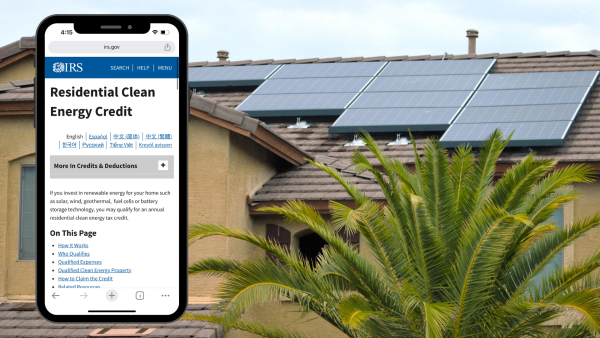
How to Claim the Solar Tax Credit in 2025
If you’re planning to install residential solar panels in 2025, you don’t want to miss out on the federal solar tax credit. The solar tax credit is a solar incentive that reduces your federal income tax liability by 30% of your solar installation costs. It can save you thousands of dollars on your solar installation!
It’s easy to claim the solar tax credit. All you have to do is add the solar tax credit to your federal tax return when you file—no application necessary. It’s a simple process, and we put together a step-by-step guide to walk you through it.
Let’s get started.
How to Claim the Federal Solar Tax Credit Step-by-Step
Step One: Save Your Receipts
To claim the tax credit for solar panels, you’ll need to add up all costs associated with your solar installation to calculate the correct credit amount. This will be easiest if you save your receipts and have them on hand when filing your taxes.
Almost every expense related to a solar panel installation is eligible for the solar tax credit, including:
- Solar PV panels
- Installation labor
- Wiring, inverters, and mounting equipment
- Solar batteries
- Sales taxes on eligible expenses
Step Two: Complete IRS Form 5695
When you file your taxes, you’ll need to complete IRS Form 5695. You’ll use this form to calculate your tax credit amount. The solar tax credit is formally known as the Residential Clean Energy Credit, which is what you’ll see it called on all tax documents. Instructions for completing the IRS solar tax credit Form 5695 can be found here.
Step Three: Add Your Tax Credit Information to IRS Form 1040
The last step is to add your tax credit information to your typical IRS Form 1040/Schedule 3. Remember to attach Form 5695 when you file your tax return.
FAQs About Claiming the Solar Tax Credit
SouthFace Solar & Electric has been installing solar panels in Arizona for years. We’ve helped thousands of homeowners navigate the solar tax credit for their solar installations and have answered plenty of questions about it. Here are some of the most common questions our customers ask about claiming the solar tax credit:
How many times can you claim the solar tax credit?
The solar tax credit is a one-time credit. You can only claim it for the initial installation of your solar panel system. If you install solar panels on a second home, you may claim the credit again. But, if the second home is used as a rental property, it may not be eligible.
Can the solar tax credit be rolled over?
Yes, the solar tax credit can be rolled over. If the credit you receive is worth more than what you owe in taxes, you will be able to roll the remainder over into the following year.
When does your installation need to be completed to qualify for the solar tax credit?
The solar tax credit will be available until 2035 (although it will be reduced in value starting in 2033). To claim the tax credit in a given year, you need to complete your solar installation before the end of that year. If you want to claim the credit on your 2025 taxes, you need to complete your solar installation and turn your system on no later than December 31, 2025.
Start Your Solar Installation Today with Arizona’s Leading Solar Installer
SouthFace Solar & Electric is a leading solar installation company in Arizona, specializing in rooftop, ground-mounted, and off-grid solar. We can help you take advantage of solar incentives like the federal solar tax credit to reduce your solar installation costs and help you go solar faster. Check out our FAQs to learn more about how the solar tax credit works and for answers to all your questions about switching to solar.
Disclaimer: This material is for informational purposes only. We always recommend speaking with a tax professional before making tax-related decisions.





